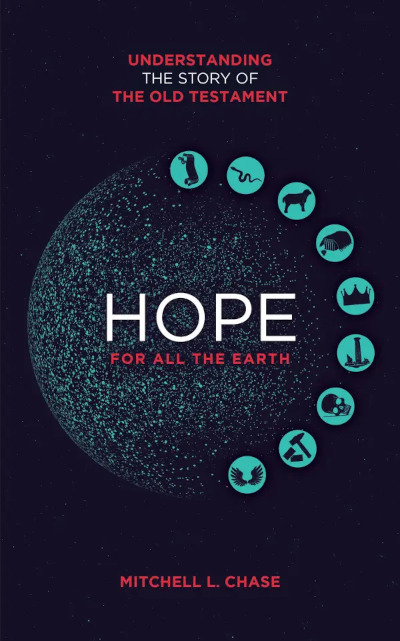In Hope for All the Earth, Mitchell L. Chase delivers a concise and readable synopsis of Old Testament events and Christ’s shadows throughout.
In nine short chapters, Chase presents the grand story of the Old Testament, from Genesis to Malachi, even briefly describing the intertestamental period before the gospel of Matthew begins.
The book is very short (88 pages) and sometimes a bit choppy as the author moves quickly through the major events and Christic shadows of the O.T. But if the goal of this book is to provide a short “study guide” of the Old Testament, I think Mitchell L. Chase hit it out of the park. It’s not academic; I don’t recall any difficult theological lingo, like typology, anachronism, or antinomianism. Just accessible explanations of the Old Testament.
Introduction: The Bible Jesus Read
The book begins with a timeline of major Old Testament events, and in only a couple of pages, Chase presents the first 39 books of the Bible as the scriptures available to Jesus and his disciples. He also introduces the patterns of the Old Testament that point to Christ. As Jesus read the ancient words of the faith, he would have discerned in the Scriptures that he was the covenant Son, the true Israel, the promised king, the greater temple, and the perfect priest.
Each of the eight chapters covers a distinct period of Old Testament history, from creation to the birth of Israel to the rise and fall of the monarchy—addressing every section of the Old Testament.
- In and Out of Sacred Space
- A Family That Becomes a Nation
- From Egypt to the Promised Land
- The Kingdom’s Rise and Demise
- Death by Defeat and Exile
- Hope in the Dark
- Going Back and Going Up
- Looking for an Ending
The first chapter
In the story of creation we find the first people, Adam and Eve, living in a sacred space called the garden of Eden. Eden was sacred because it was set apart from the rest of creation as a space that God himself inhabited with his created people—his image bearers. Adam and Eve represented God in creation, tasked with subduing and exercising dominion over the land as they became fruitful and multiplied (Gen. 1:26–28).
As Mitchell Chase unfolds the story of creation and the fall of humanity, we read that after the sin of Adam and Eve, they receive curses by God—to Adam, work would be harder, and to Eve, childbirth would be painful. Their tempter, the serpent, also receives a curse—and a prophecy. In Genesis 3:15, the serpent’s offspring will be crushed by the woman’s offspring; the seed of the woman will be struck by the seed of the serpent. The serpent will be judged (
he will crush your head
), but the future son’s victory will be through suffering (you will strike his heel
).
After the fall, Adam and Eve became aware and ashamed of their nakedness, but God still cared for their needs by providing animal skins as clothing, foreshadowing the importance to Israel of animal offerings being given in the place of sinners. God would shed blood to bring atonement. Ultimately Jesus himself would give his life so that we might be clothed in his righteousness.
But for now, Adam and Eve would be exiled from the sacred garden; God sent them out to the east and placed cherubim and a flaming sword to guard the entrance.
Expecting Jesus
Each chapter ends with an “Expecting Jesus” section and recommended Bible reading. “Expecting Jesus” is where Mitchell Chase highlights the Christological “shadows” in the Old Testament—places where Scripture alludes to Jesus Christ, even without direct prophecies concerning the Messiah. Some examples from the book include:
Jesus is the promised Seed of the woman who would defeat the serpent and overcome the curse.
(Chapter 1: In and Out of Sacred Space)Jesus is the Passover lamb whose blood shields sinners who come to him by faith.
(Chapter 3: From Egypt to the Promised Land)The ministry of Jesus was a conquest subduing the principalities and powers of this age as well as the effects of sin in this world.
(Chapter 4: The Kingdom’s Rise and Demise)The saving work of Jesus was a new exodus movement leading sinners away from their captivity to sin, Satan, and death.
(Chapter 6: Hope in the Dark)Jesus is the true temple that was destroyed by death and rebuilt by resurrection.
(Chapter 7: Going Back and Going Up)

Symbolism
Mitchell Chase does a good job in the book of pointing out symbolism that might otherwise go unnoticed. There are so many symbols in the Bible. Just like animal sacrifices pointed back to God’s provision of skin coverings for Adam and Eve, so the tabernacle’s eastern entrance pointed back to the garden of Eden.
An eastern entrance is a deliberate callback to the Garden of Eden, for cherubim had guarded the eastern entrance after the exile of Adam and Eve (Gen. 3:22–24). Going into the tabernacle symbolized the return to Eden.
The tabernacle itself pointed forward to Jesus Christ, who came to earth and tabernacled (dwelled) among his people like never before.
Conclusion
Mitchell L. Chase did a fantastic job with this short book. I think it’s a great read for both new and mature Christians. It’s very affordable and could make a great subject for a Bible study group to read through and discuss, especially while also going through Chase’s suggested readings at the end of each chapter. I can wholeheartedly recommend Hope for All the Earth to anyone who wants to better understand the relationship between the Old Testament and the New.
Note: I received this book for free from the author as part of a bundled giveaway on Twitter. I’m under no obligation to review any of the books, much less write a good review. (Mr. Chase signed each book, though, which I thought was a nice touch.)
